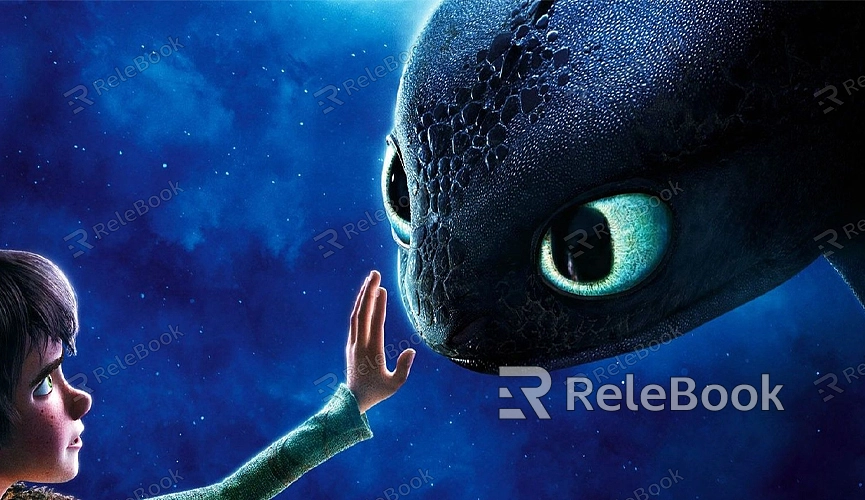How to train your dragon toothless 3d model
How to Train Your Dragon is a beloved animated film, and Toothless is a fan-favorite character. If you're a 3D enthusiast or game developer, you might want to create a 3D model of Toothless. Crafting a high-quality Toothless model requires not only basic modeling skills but also an understanding of details and textures. This article will provide practical steps and tips to help you successfully create a 3D model of Toothless.
Planning and Preparation
Before you begin modeling Toothless, thorough planning is essential. Look at images and videos of Toothless from the movie to understand his appearance, details, and movements. You can find plenty of reference material online that will help you capture Toothless's essence during the modeling process.

Additionally, prepare some basic design sketches and reference images, as these will be key in creating your model. Sketches can help maintain proportions and details while modeling.
Use the Right Modeling Software
To create a 3D model, you'll need modeling software. Blender, Maya, and 3ds Max are popular modeling tools. Blender is an open-source, powerful software suitable for various 3D modeling needs. For a complex model like Toothless, Blender's versatility and flexibility will aid you in achieving detailed work.
Start Modeling
1. Create Basic Shapes: Begin by creating the basic shapes of Toothless in your modeling software. Use simple geometric shapes (like spheres and cubes) to construct the main volume of Toothless. This step is primarily about establishing the overall structure and proportions of the model.
2. Refine the Model: Once you have the basic shape, gradually add more detail. By subdividing the model’s surfaces, adding more geometric details, and adjusting shapes, make the model closer to Toothless's true appearance. Refer to images from the movie to ensure accuracy in details.
3. Add Features: During the refinement process, pay special attention to Toothless's characteristics, such as scales, claws, and tail. These details are crucial for making the model look more realistic.
Textures and Materials
Create Texture Maps
Toothless's appearance relies not just on the shape of the model but also on textures and materials. Creating texture maps is an important step in this process. You can use image editing software like Photoshop to create texture maps, including textures for the dragon's scales and eyes.
Use High-Quality Textures
Using high-quality texture maps is vital for enhancing the model’s realism. If you need many high-quality 3D textures and HDRIs while creating your models and virtual scenes, you can download them for free from [Relebook](https://textures.relebook.com/). For stunning 3D models, visit [Relebook](https://3dmodels.relebook.com/), which offers a wide array of premium 3D resources. These assets can help improve the detail and quality of your Toothless model.
Apply Materials
Applying materials to your model is key to achieving the final look. Setting the correct material properties (like glossiness and reflectivity) can make Toothless appear more lively and realistic. Ensure that the materials complement the textures to portray Toothless’s true appearance.
Animation and Posing
If you want your Toothless model to be more than just a static figure, you’ll need to add bones and weights for animation. Create a skeletal system for Toothless and bind the bones to the model to enable various movements. You can then set different poses and actions to simulate Toothless’s dynamic effects.
Create Animations
Use animation tools to create movements for Toothless. You can design actions like flying, walking, or attacking, applying these movements to your model. Animation brings your model to life, making it more expressive.
Rendering and Output
Once your model is complete, the final step is rendering. Choose appropriate rendering settings to ensure that the final output meets your expectations. Set up lighting, camera angles, and other elements to achieve high-quality rendering.
Export the Model
After rendering, export the model in common 3D file formats (like .obj or .fbx) for use in other software or for further processing.
Creating a 3D model of Toothless from How to Train Your Dragon is a complex but enjoyable process. Through careful planning, using suitable modeling software, refining model details, creating high-quality textures, applying materials, animating, and rendering, you can create a high-quality Toothless 3D model.
Remember, if you need high-quality 3D textures and HDRIs while creating your models and virtual scenes, you can download them for free from [Relebook](https://textures.relebook.com/). For beautiful 3D models, check out [Relebook](https://3dmodels.relebook.com/) as well, offering a vast selection of premium 3D resources to save you time and enhance your projects.

